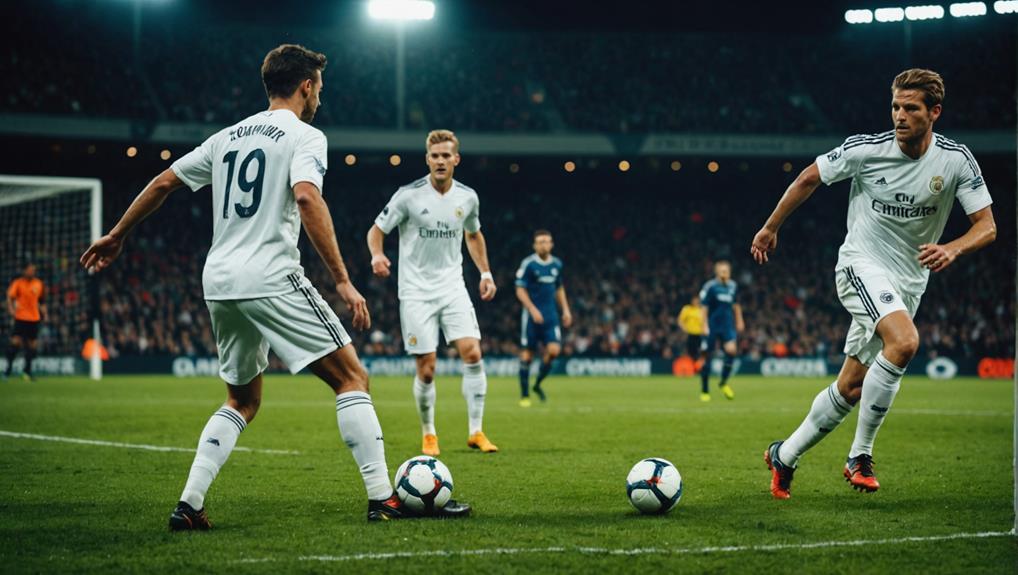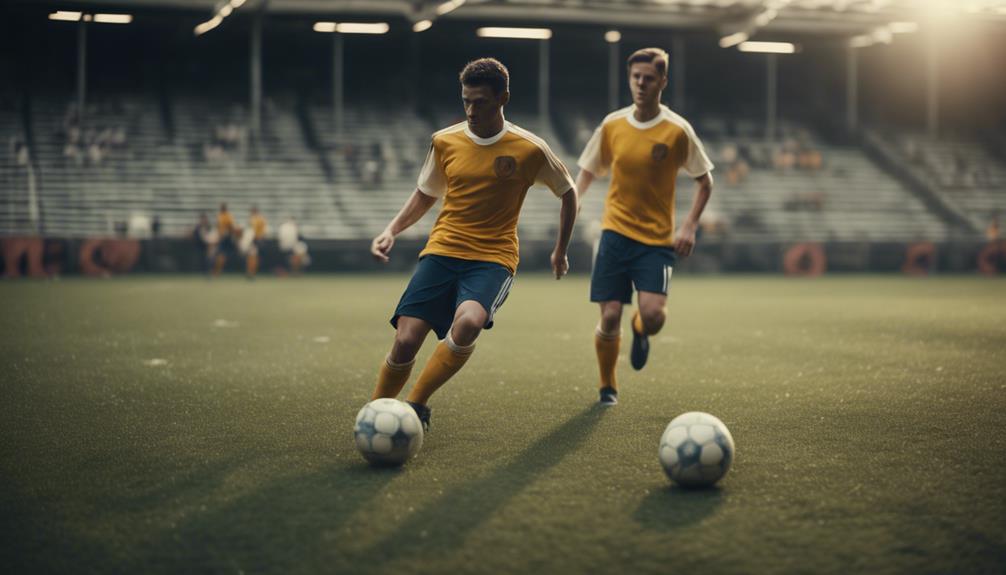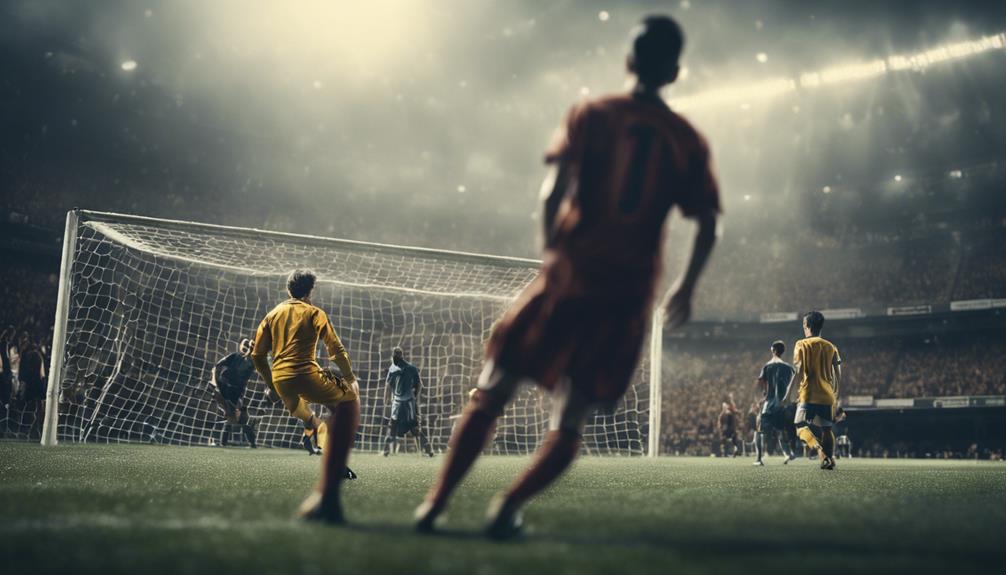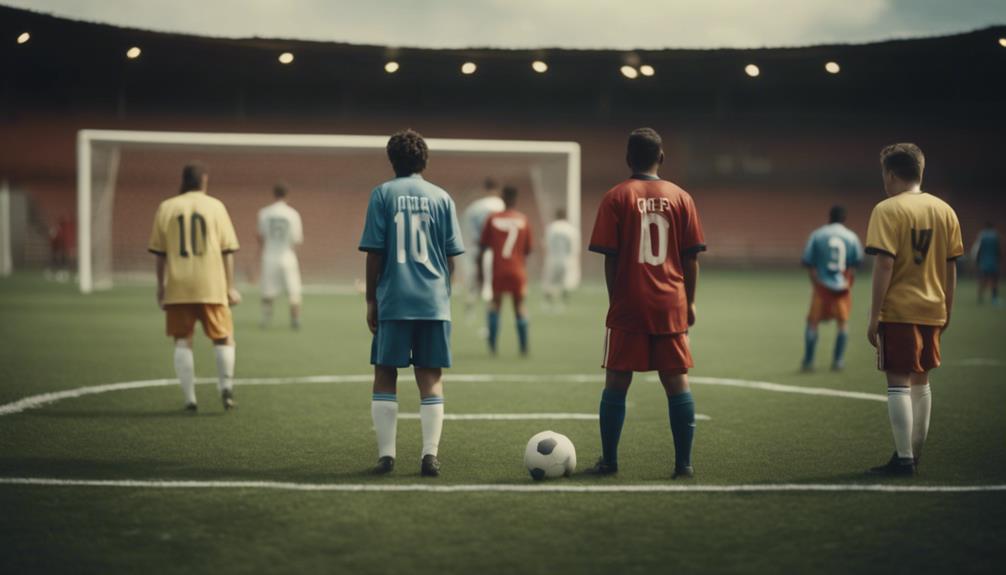
Understanding the Basics of Soccer Positions
August 22, 2024To understand soccer positions, know that defenders like center-backs and full-backs anchor your defense, while midfielders control the game's pace and connect defense to attack. Offensive positions like strikers and attacking midfielders focus on scoring goals and creating opportunities. The field is divided into zones for defending, midfield, and attacking, each with specific purposes in gameplay. Key defensive roles like goalkeepers, center-backs, and full-backs are essential for a solid defense. Learning these basics sets the groundwork for appreciating the intricate strategies and skills involved in each position on the soccer field.
Defensive Soccer Positions
When playing soccer, understanding defensive positions is fundamental for effectively preventing opponents from scoring goals. Defensive players like center-backs and full-backs play pivotal roles in maintaining a solid defense on the field. Center-backs are positioned in the center of the defense, responsible for marking the opponent's strikers and breaking up their attacks. They're essential in organizing the defense, anticipating plays, and initiating counterattacks.
On the other hand, full-backs operate on the sides of the field, providing defensive support and contributing to offensive plays. Whether as right full-backs or left full-backs, their speed and tackling abilities are crucial in neutralizing opposition wingers and supporting their teammates.
Both center-backs and full-backs need to possess skills such as physical strength, anticipation, and precise tackling to excel in their defensive duties.
Understanding the distinct roles of defensive players like center-backs and full-backs is vital in building a strong defensive foundation for your soccer team. By mastering these positions, you can effectively thwart opponents' scoring attempts and contribute to your team's success on the field.
Midfield Soccer Positions
As a soccer player, you'll find that central midfielders are the heartbeat of the team. They possess exceptional passing skills, vision, and decision-making abilities, influencing the game's tempo and direction.
Wide midfielders, on the other hand, excel in speed, crossing accuracy, and providing width to the team's attacking play.
Central Midfielder Attributes
Central midfielders play a pivotal role in soccer matches by controlling the game's tempo and connecting the defense with the attack. Their effectiveness hinges on exceptional passing and vision. With the ability to spot opportunities and distribute the ball accurately, central midfielders dictate the flow of the game.
These players often don jersey numbers 6, 8, or 10 in traditional formations, symbolizing their importance on the field. The central midfielder's skill set extends beyond passing and vision; they must also possess sharp decision-making abilities. These players act as the engine room of the team, supporting defensive efforts while orchestrating attacks.
Their role demands versatility, as they must seamlessly shift between defensive and offensive responsibilities throughout the game. Renowned figures like Xavi Hernandez and Andrea Pirlo exemplify the impact central midfielders can have on a match. Their mastery of passing, vision, and decision-making has solidified their places among the sport's elite.
Wide Midfielder Skills
Wide midfielders, also known as wingers, showcase their skills by providing width to the team's attack and delivering crosses into the box. As a wide midfielder, your ability to stay wide on the field is essential in stretching the opponent's defense and creating space for your teammates.
Your primary task is to deliver accurate crosses into the box, providing your team scoring opportunities. To excel in this position, you must possess a combination of speed, dribbling, passing, and exceptional crossing ability.
Furthermore, cutting inside from the wing can allow you to take shots on goal or support overlapping fullbacks in the attack. Developing strong positional awareness, vision, and decision-making skills will help you exploit gaps in the opponent's defense effectively.
Mastering these skills as a wide midfielder will elevate your team's attacking prowess and contribute significantly to your overall performance on the field.
Offensive Soccer Positions

Focusing on attacking the opponent's goal, offensive soccer positions demand players with exceptional shooting ability and strategic positioning on the field. Strikers are the forefront of the attack, relying on speed, accuracy, and quick decision-making to score goals.
Meanwhile, attacking midfielders act as playmakers, creating scoring opportunities and bridging the gap between defense and offense.
To excel in offensive positions, players must possess a unique set of skills:
Strikers: These offensive players are goal-hungry and need to showcase not only their shooting prowess but also composure in front of the net and intelligent movement to outwit defenders.
Attacking Midfielders: As the creative minds of the team, attacking midfielders must have exceptional technical skills to deliver precise passes and through balls, ultimately setting up goal-scoring chances.
Notable Players: Icons like Pelé, Messi, and Ronaldo, along with modern talents such as Phil Foden, Bernardo Silva, and Jamal Musiala, exemplify the excellence required in offensive soccer positions.
Soccer Field Zones
Moving from discussing offensive soccer positions, understanding soccer field zones is vital for players to effectively execute their roles on the pitch.
A standard soccer field is 105 meters long and 68 meters wide, providing ample space for players to maneuver. The field is typically divided into defensive, midfield, and attacking zones to help players understand their roles and positioning.
Defenders focus on maintaining possession and preventing opponents from scoring in the defending zone, while midfielders play an important role in passing the ball and shifting from defense to attack in the midfield zone.
In the attacking zone, midfielders aim to create scoring opportunities by passing the ball into spaces for forwards to capitalize on.
Understanding these zones is key to coordinating movements and strategies effectively during a match, ensuring that players are in the right place at the right time to support their team both defensively and offensively.
Key Defensive Roles

As a soccer player, understanding key defensive roles is vital for your team's success.
Defensive players have essential responsibilities like marking opponents, intercepting passes, and clearing the ball.
Mastering defensive skills and positioning on the field will greatly impact your team's performance.
Defensive Players' Roles
Defensive players in soccer, including goalkeepers, center-backs, full-backs, and wing-backs, play pivotal roles in preventing opponents from scoring. Understanding the specific responsibilities of each defensive position is essential for a strong defensive line.
Here are three key defensive roles you should be aware of:
- Defensive Midfielder: A defensive midfielder acts as a shield in front of the backline, intercepting passes, breaking up opposition attacks, and distributing the ball to start offensive plays. They're the link between defense and midfield, providing stability and support to both areas.
- Center Backs: Center-backs are the foundation of the defense, tasked with marking opponents, clearing dangerous balls, and organizing the defensive line. They're typically physically imposing players who excel in aerial duels and are vital in stopping opposition attacks.
- Fullbacks: Full-backs provide defensive cover on the flanks while also supporting the team's attack. They need to be versatile, capable of defending against speedy wingers and contributing to offensive plays by providing width and delivering crosses into the box.
Key Defensive Skills
Essential attributes, such as stamina, agility, strength, and communication, are key components of mastering defensive skills in soccer positions. Defenders play a vital role in protecting the goal and initiating attacks from the back. Full-backs, center-backs, and wing-backs need to excel in reading the game, making pivotal tackles, and providing offensive support.
Additionally, goalkeepers act as the last line of defense, requiring skills like catching, reflexes, agility, and distribution to kickstart attacking plays effectively. Defensive midfielders also play a pivotal role in breaking up opponent attacks, shielding the defense, and creating scoring opportunities, demanding good stamina, strength, and game reading abilities.
Understanding the specific demands of each defensive position in soccer positions is crucial for players looking to excel in these key defensive roles. Mastering these defensive skills is essential for a well-rounded defensive unit that can effectively thwart opponents and support the team in both defensive and offensive phases of the game.
Defensive Position Importance
Understanding the roles and significance of defensive positions in soccer is fundamental for building a strong defensive unit. Defenders play a critical defensive role in the team, ensuring opponents have a tough time scoring goals.
Here are three key defensive positions that are essential for a solid defensive structure:
- Center-backs: These defenders are positioned in the central area of the defense and are responsible for thwarting attacks through strong tackling, aerial duels, and organizing the defensive line.
- Full-backs: Full-backs cover the flanks of the defense, providing support to both the defense and the attack. They need to be quick, possess good stamina, and have excellent crossing abilities.
- Defending midfielders: These players act as a shield for the defense, breaking up opposition attacks, and distributing the ball efficiently to start counter-attacks. They play a vital role in shifting play from defense to offense, offering crucial support to both defensive and attacking phases of the game.
Midfielder Responsibilities
Midfielders play a pivotal role in orchestrating the flow of the game and connecting the defense with the attack through strategic positioning and precise passing. As a midfielder, your responsibility is to control the midfield, acting as the link between the defensive line and the forwards. By doing so, you not only support the defense when needed but also play an essential role in creating scoring opportunities for your team.
Understanding the different midfielder positions is vital. Whether you're a defensive midfielder, an attacking midfielder, a central midfielder, or a wide midfielder, each position comes with specific responsibilities that contribute to the team's overall strategy. Your stamina, technical skills, vision, and game-reading abilities are crucial for excelling in these roles.
Attacker Skills

To excel as an attacker in soccer, mastering skills like finishing, positioning, movement, and hold-up play is essential for effectively scoring goals. Here are key elements to focus on:
- Finishing: Attacking players must hone their ability to strike the ball accurately and powerfully to beat the goalkeeper. Techniques like side-foot finishing, volleys, and headers are pivotal for converting scoring opportunities.
- Positioning: Understanding where to be on the field at any given moment is crucial for attackers. Knowing how to exploit gaps in the defense, stay onside, and create space for teammates is indispensable for maximizing goal-scoring chances.
- Movement: Dynamic movement off the ball is a hallmark of successful attackers. Utilizing runs like diagonal runs, curved runs, and overlapping runs can confuse defenders and create openings for shots on goal.
Mastering movement patterns can make a significant impact in breaking through defenses and finding the back of the net efficiently.
Player Development Importance
You must focus on player growth strategies and skill enhancement approaches to excel in different soccer positions.
By developing your skills in specific roles, you can improve your adaptability and contribute effectively to your team's success.
Understanding the importance of player development will elevate your game and help you make strategic decisions on the field.
Player Growth Strategies
Developing as a soccer player requires consistent focus on honing skills, understanding tactics, and enhancing overall performance on the field. To foster player growth effectively, consider the following strategies:
1. Tailored Training Programs:
Creating individualized training routines based on player development needs can greatly enhance technical abilities, decision-making skills, and game awareness.
2. Regular Practice and Feedback:
Consistent practice sessions coupled with constructive feedback from coaches and teammates play an essential role in improving performance and fostering growth.
3. Competitive Opportunities:
Providing chances for players to apply learned skills in competitive game situations is crucial for translating training into real-game scenarios and boosting confidence levels.
Skill Enhancement Approaches
Skill enhancement approaches in soccer emphasize the development of technical abilities, tactical understanding, physical fitness, and mental resilience for players.
Player development programs are designed to offer personalized training sessions, feedback, and goal-setting to enhance specific skills and overall performance. These programs utilize advanced technology such as video analysis, performance tracking tools, and virtual training platforms to facilitate skill enhancement.
Coaches play an essential role in guiding players through structured training sessions, drills, and game simulations to effectively enhance their skills. Regular practice, dedication, and a growth mindset are essential for players to continually improve and reach their full potential in soccer positions.
Jersey Numbers Significance

When it comes to soccer, jersey numbers hold significant meaning as they're traditionally associated with specific positions on the field. Understanding the significance of jersey numbers can give you insights into the roles players are expected to fulfill during a match.
Here are some key jersey number associations in soccer:
- Goalkeepers typically wear the number 1 jersey, symbolizing their role as the last line of defense and their unique position on the field.
- Center-backs are commonly seen wearing numbers 4 or 5, indicating their defensive duties and central positioning in the backline.
- Forwards and strikers often don numbers 7, 9, or 11, reflecting their responsibilities in scoring goals and leading the attacking line.
Attacking Roles
Understanding attacking roles in soccer is essential for grasping the dynamics of goal-scoring opportunities on the field. Forwards, such as strikers and wingers, are tasked with finding the back of the net. They rely on skills like speed, accuracy, and quick decision-making to outsmart the opposition's defense.
On the other hand, attacking midfielders, like playmakers, play a vital role in creating goal-scoring chances. These players act as the link between defense and offense, setting up opportunities for the team to score.
To excel in attacking positions, players must possess key skills such as shooting accuracy, composure under pressure, technical prowess, and intelligent movement off the ball. Some of the greatest players in history, like Pelé, Lionel Messi, and Cristiano Ronaldo, have showcased their talent in these attacking roles, becoming prolific goal scorers and legends of the game.
Mastering the art of attacking is crucial for any team looking to dominate in the final third and secure victories on the pitch.
Conclusion
Now that you've explored the basics of soccer positions, you're ready to hit the field and make your mark.
Like pieces on a chessboard, each player has a unique role to play in the game's strategy.
Remember, soccer is a beautiful dance between defenders, midfielders, and attackers, each moving with precision and purpose.
So lace up those cleats, get out there, and show the world what you're made of. The game is waiting for you.


